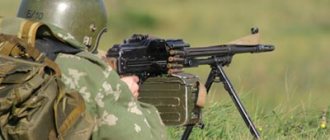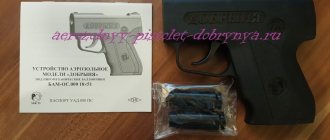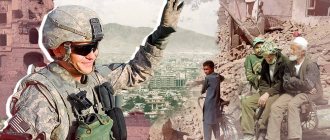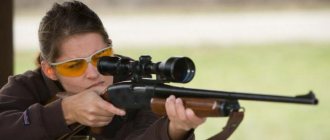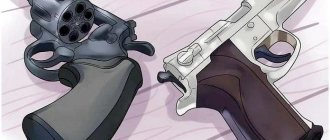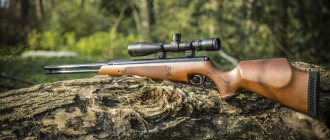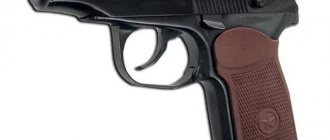Shooting at a moving target with a leash
Science has established that the human motor reaction time is about 0.02 seconds. The operating time of the trigger mechanism until the firing pin hits the primer is 0.011 seconds. Ignition of the primer, combustion of gunpowder and movement of the projectile along the barrel to the muzzle takes 0.003 seconds.
Thus, from the beginning of the action, when the shooter decided to shoot, until the shot leaves the barrel, 0.024 seconds pass. During this time, a bird flying at a speed of 20 m/sec will fly 48 cm, so the shot shell will pass behind the target. To prevent this from happening, they make a so-called leash, that is, they do not stop the guns during the shot, but continue to move the barrels along with the target.
However, even a leash will not save the hunter from a miss if you do not take into account the flight time of the shot from the muzzle of the barrel to the target. No matter how fast the shot flies, it still takes time. For example, shot No. 7 flies the first 20 m in 0.07 seconds. During the same time, a bird flying at a speed of 20 m/sec will move 1.4 m, so that the center of the shotsheaf will pass behind at the same distance.
Consequently, in order to hit a moving target, you need to not only follow the target with your barrels, but also take a lead , that is, aim at a point forward along the bird’s flight line.
Calculation of lead when firing
The amount of lead depends on the target's flight speed and distance to it; it is determined by the formula S=vt, where S is the lead, v is the bird’s flight speed in m/sec and t is the shot’s flight time to the target.
The speed of movement of the most common hunting birds and animals, as well as the flight time of shot of different numbers at different distances are given in the tables below.
Average speed of movement of birds and animals
| Animal name | Speed(m/sec) |
| Goose | 18–22 |
| Mallard | 18–27 |
| Teal | 18–35 |
| Capercaillie, black grouse. | 15–18 |
| Partridge | 13–14 |
| Snipe | 15–22 |
| Hare | 7–10 |
Shot flight time at various distances
| Distance in m | Fraction numbers | Buckshot | ||||
| 1 | 3 | 5 | 7 | 9 | ||
| 20 | 0,06 | 0,06 | 0,06 | 0,07 | 0,07 | 0,06 |
| 30 | 0,10 | 0,10 | 0,10 | 0,11 | 0,11 | 0,09 |
| 40 | 0,14 | 0,14 | 0,15 | 0,16 | 0,17 | 0,13 |
| 50 | 0,18 | 0,19 | 0,20 | 0,22 | 0,24 | 0,16 |
The following practical example will make the definition of preemption clearer.
The hunt for wood grouse is underway. The cartridges are filled with shot No. 5. According to the above table, the capercaillie flies at a speed of 15 m/sec. The distance from the capercaillie to the hunter is 30 m. From the table with the flight time of the shot, it can be seen that shot No. 5 flies this distance in 0.10 seconds. Multiplying 15 by 0.10 we get the required lead - 1.5 m. You can take a ready-made one. lead value from the table below. The amount of lead at different flight speeds of birds
| Distance in m | Fraction numbers | Bird flight speed and lead | ||
| 15 m/sec | 25 m/sec | 35 m/sec | ||
| 15 | 7 | 0,74 | 1,23 | 1,73 |
| 5 | 0,73 | 1,22 | 1,70 | |
| 25 | 3 | 0,72 | 1,20 | 1,68 |
| 7 | 1,31 | 2,18 | 3,06 | |
| 5 | 1,27 | 2,12 | 2,96 | |
| 35 | 3 | 1,23 | 2,06 | 2,88 |
| 7 | 1,99 | 3,32 | 4,65 | |
| 5 | 1.91 | 3,19 | 4,47 | |
| 3 | 1,84 | 3,07 | 4,29 | |
Leash and shooting at a moving target
While releasing the trigger, be sure to continue the leash . Stopping the gun or slowing down the leash at the moment of releasing the trigger and firing inevitably leads to a miss.
Every shooter must remember and strictly follow a very important rule - the barrels of the gun, regardless of the direction of movement - to the side, up or down - are driven not with the hands, but with the body . They just raise the gun with their hands. During subsequent movements, the arms should not change their position relative to the body. The hunter's arms, gun and torso are like a fixed system that changes position only by turning and bending the torso .
When shooting at a moving target, the gun is directed in advance to the place where the bird or animal is expected to appear. So, if a partridge is expected to fly out of the grass about ten meters from the shooter, then the trunks go down. In this case, it is easier to immediately catch the bird on the fly, overtake it with the trunks and shoot, not allowing it to fly further than 20–25 m.
When waiting for ducks to fly, the ends of the gun barrel should be held at eye level or higher, depending on the height of the ducks' flight that evening.
The shooter himself must always stand half a turn to the place where the bird will be at the moment of the shot, and, while waiting for the target, he must turn towards it without moving his feet.
Comparison of leads of the .308 168 grain bullet and the M118LR bullet.
I prefer the "counting by sevens" method, which doubles the lead for a trotting target and/or halves the lead for an oblique target. You can simply memorize the leads and do the same: 1, 2, 3, 4, 5, 6 and 7. The most suitable method is the one that works best for you.
General provisions
126. To successfully complete tasks in battle it is necessary.
- continuously monitor the battlefield;
— correctly choose and skillfully camouflage the place for shooting;
— quickly and correctly prepare data for shooting;
— skillfully fire at all kinds of targets in various conditions day and night; to hit group and most important single targets, use concentrated sudden fire;
- observe the results of the fire and skillfully adjust it;
- monitor the consumption of ammunition in battle and take measures to receive them in a timely manner.
Shooting while the shooter is moving
165. Shooting while the shooter is moving (on the move, from an armored personnel carrier, car, from ferrying vehicles afloat) is possible from a short stop and without stopping.
From a short stop
(on the move, from an armored personnel carrier, car), as well as afloat, in the absence of significant movement of the transport vehicles, aimed fire is conducted according to the same rules as when shooting from a standstill.
When driving without stopping
on an armored personnel carrier, a car on uneven terrain or on ferry vehicles in the presence of large waves, the carbine is aimed at the target along the barrel without using a sight.
To better adjust fire, use cartridges with tracer bullets.
Battlefield surveillance and target designation
127. Observation is carried out in order to timely detect the location and actions of the enemy. In addition, in battle it is necessary to observe the signals (signs) of the commander and the results of his fire.
Unless there are special instructions from the commander, soldiers conduct surveillance in the sector of fire indicated by him to a depth of 1000 m.
128. Observation is carried out with the naked eye. When observing, pay special attention to hidden approaches. Inspect the area from right to left from near objects to distant ones. It is advisable to carry out an inspection, since even minor signs and phenomena (shine, noise, swaying branches of trees and bushes, the appearance of new small objects, changes in the position and shape of local objects) can make it easier to detect the enemy.
If you have binoculars, use them only for a more thorough study of individual objects or areas of the terrain, while taking measures to ensure that the shine of the binocular glasses does not reveal your location.
At night, the location and actions of the enemy can be determined by sounds and light sources. Therefore, at night you need to listen carefully to all kinds of sounds. If the desired direction is illuminated by a rocket or other means of illumination, quickly inspect the illuminated area.
129. Targets spotted on the battlefield must be immediately reported to the commander and their location correctly indicated. The target is indicated by verbal report or tracer bullets.
The report should be short, clear and precise, for example: “Straight is a wide bush, to the left is a machine gun,” “Second landmark, two fingers to the right, under the bush is an observer.”
.
When aiming with tracer bullets, fire one or more shots in the direction of the target.
Choosing the moment to open fire
142. The moment to open fire is determined by the commander’s “Fire” command, and in the case of independent fire, depending on the situation and the position of the target.
The most favorable moments to open fire; when the target can be hit suddenly, when the target is clearly visible, when the target is crowded, puts up a flag or rises to its full height.
A sudden fire attack on the enemy, especially from the flank, has a stunning effect on him and gives the greatest effect.
Shooting under the influence of toxic and radioactive substances
164. Shooting under conditions of exposure to toxic and radioactive substances is carried out wearing personal protective equipment.
If, when shooting in a gas mask, the mane of the sight and the front sight are not visible, the carbine is aimed along the barrel.
When firing in an area contaminated with toxic substances or radioactive warfare agents, you should protect from them and degass (decontaminate) first of all those parts of the carbine that come into contact when shooting. The shooting rules are the same as for shooting under normal conditions.
Shooting in the mountains
156. When shooting in the mountains, it is necessary to adjust the sight setting, corresponding to the distance to the target, to make adjustments for the height of the terrain (to reduce air density with increasing elevation of the terrain above sea level) and for the elevation angle of the target.
To determine the correction for terrain height, use the following table.
| Firing range, m | Height of the area above sea level, m | ||||
| 1000 | 1500 | 2000 | 2500 | 3000 | |
| Corrections in sight divisions (reduce sight) | |||||
| 300 | ― | ― | ― | ½ | ½ |
| 400 | ― | ― | ― | ½ | ½ |
| 500 | ― | ½ | ½ | ½ | 1 |
| 600 | ½ | ½ | ½ | 1 | 1 |
| 700 | ½ | ½ | 1 | 1 | 1 |
| 800 | ½ | 1 | 1 | 1½ | 1½ |
The correction for the target elevation angle is determined using the following table.
| Firing range, m | 200 | 300 | 400 | 500 | 600 | 700 | 800 |
| Target elevation angle in degrees | Corrections in sight divisions (reduce sight) | ||||||
| — 45 | ½ | ½ | 1 | 1 | 1 | 1 | 1 |
| — 30 | ― | ½ | ½ | ½ | ½ | ½ | ½ |
| + 30 | ― | ½ | ½ | ½ | ½ | ½ | ½ |
| + 45 | ½ | ½ | 1 | 1 | 1 | 1 | 1 |
Conducting fire, monitoring its results and adjusting
143. When firing, the shooter must carefully observe the results of the fire and adjust it.
Rice. 75. Taking out the aiming point
Observation of the results of your fire is carried out by ricochets, routes and the behavior of the enemy.
The fire is adjusted by moving the aiming point by the amount of deviation of the ricochets or tracks in the direction opposite to their deviation (Fig. 75). To adjust fire along the routes, it is necessary to use cartridges with tracer bullets.
144. Signs indicating the reality of one’s fire can be: enemy losses, his transition from dashing to crawling, dismemberment and deployment of columns, weakening or turning of enemy fire, his retreat or retreat to cover.
Target selection
132. In combat, a shooter fires, as a rule, as part of a squad (platoon), destroying targets indicated to him by the commander. Therefore, he must listen carefully and accurately carry out all commands given by the commander, quickly find and hit targets.
133. If the shooter in battle is not given a target to hit, he chooses it himself. First of all, it is necessary to hit the most dangerous and important targets, for example, machine gun and artillery crews, commanders, and enemy observers. Of two targets of equal importance, choose the closest and most vulnerable one for shelling.
If a new, more important target appears during shooting, transfer fire to it.
Determining distances
134. The most important condition for successfully hitting a target is accurately determining the distance to it. The main way to determine distances in battle is the eye.
Knowing the distances to local objects (landmarks) makes it easier to determine distances to targets. Therefore, if the situation allows, distances to landmarks and local objects should be determined by measuring the area in steps.
135. Determination of distances by eye is carried out: by sections of terrain that are well imprinted in visual memory, by the degree of visibility and apparent size of targets (objects), or by a combination of both methods.
a) Along sections of terrain. This method is applicable only on more or less flat terrain. Such a segment can be any familiar distance that is firmly entrenched in visual memory, for example, a segment of 100, 200, 400 m. This segment must be mentally set aside from oneself to the object (goal). It should be taken into account that as the distance increases, the apparent size of the segment in perspective gradually decreases and that depressions (ravines, hollows, rivers, etc.) that cross the direction of a local object (target) conceal the distance.
b) According to the degree of visibility and apparent size of objects (targets). To use this method, it is advisable to have an individual reminder of the visibility of various objects and targets at different distances.
Below is an approximate reminder of the visibility of objects for normal vision and favorable visibility conditions (good weather, bright lighting).
| Distance, m | What is visible |
| 1000 ― 900 | You can distinguish a column of infantry from a column of cars and tanks. The outline of a human figure is visible |
| 800 ― 700 | The movements of the legs of a walking or running person are noticeable. Large branches are noticeable on the trees. The stakes of the wire fence are visible |
| 600 ― 500 | You can distinguish large details of the structure: porch, doors, windows |
| 400 ― 300 | The details of infantry weapons differ: machine gun, mortar, rifle, machine gun, etc. The color of objects and clothing is visible |
| 200 ― 100 | You can distinguish the outlines of a person’s head and shoulders, and details of equipment. The wire fencing is visible. Weapon parts visible |
The accuracy of determining distances based on the degree of visibility of objects depends not only on visual acuity, but also on the size and clarity of the outline of objects and targets, their color compared to the surrounding background, illumination, etc. So, for example:
- small objects (bushes, stones, individual figures) seem further away than large objects located at the same distance (forest, mountain, column of troops);
- objects of bright color (white, orange) seem closer than objects of dark color (blue, black, brown);
- a single-color, monotonous background of the area (meadow, snow, arable land) highlights and, as it were, brings closer the objects located on it, if they are colored differently, and a motley, varied background of the area, on the contrary, masks and, as it were, removes the objects located on it;
- on a cloudy day, in rain, at dusk, in fog, distances seem to increase, and on a bright, sunny day, on the contrary, they seem to decrease;
- in mountainous areas, visible objects seem to come closer.
136. When determining distances by measuring terrain in steps
Steps are counted in pairs. To do this, you need to know the average value of one pair of your steps in meters.
137. When determining the same distance by several soldiers, it is necessary to take the average value of all measurements as the final result.
138. At night, the distance to illuminated targets is determined by landmarks and local objects. the distance to which was determined during the day.
Choosing a shooting location
130. The shooter takes the place indicated by the commander for firing, or chooses it independently.
Shooting from a carbine can be carried out from any place from which a target or a section of terrain where a target is likely to appear is visible. Depending on the situation, the place for shooting is chosen in a trench, trench, shell crater, ditch, behind a stone, stump. In a populated area, the place for shooting can be chosen in the window of a building, in the attic, in the foundation of a building, etc.
131. It is necessary to choose a place for shooting that provides the best visibility and fire, protects the shooter from enemy observation and allows convenient shooting techniques. You should not choose a place for shooting near prominent individual local objects, as well as on the ridges of hills.
